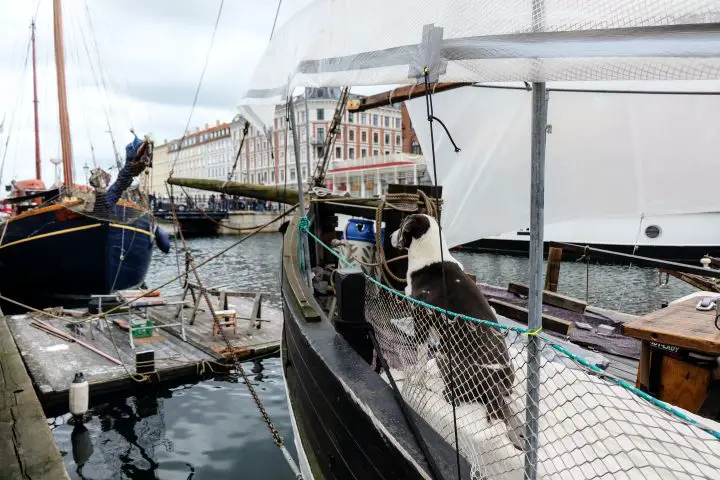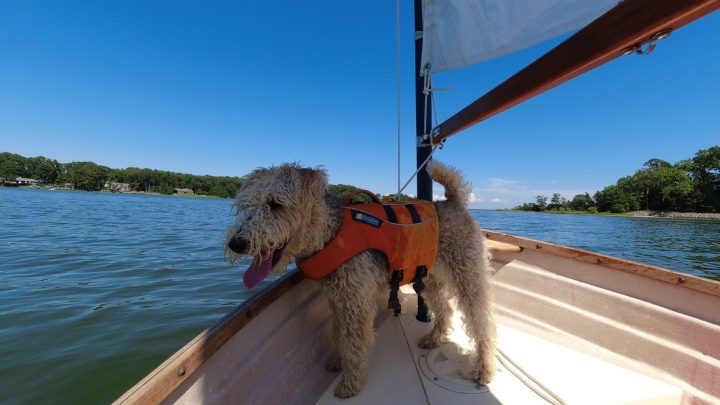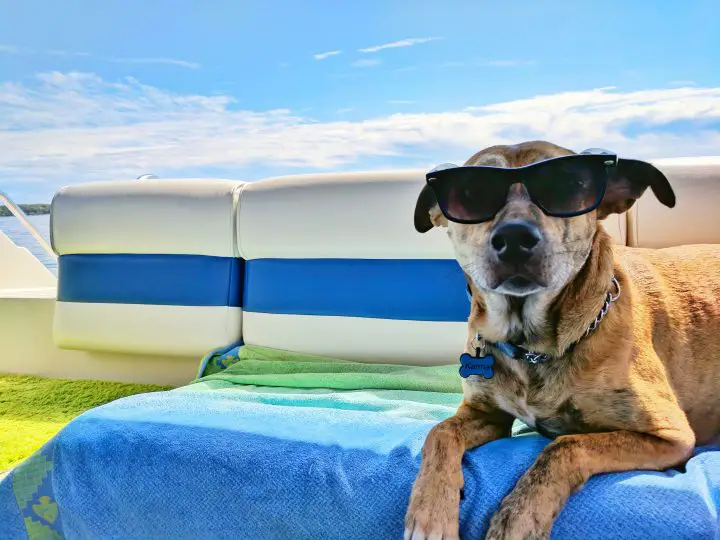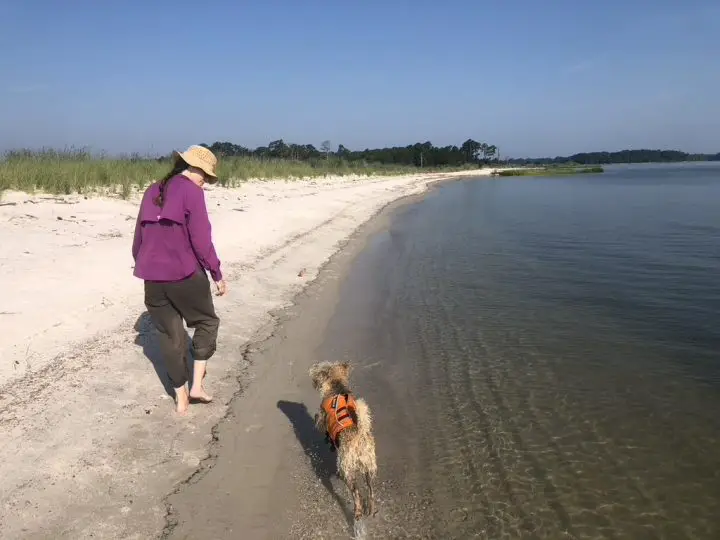If there’s a dog in your family, chances are you’ll want to take them sailing with you when you set off into the sunset. Even if your boat life dreams aren’t that grand yet, having a dog on board is part of the adventure and can add to the fun. Today we will explore further sailing with dogs.
Tons of cruisers have successfully taken their dogs boating, from living on a sailboat at cozy marinas to sailing around the world. So how do they do it? It’s a complicated issue with a lot to think about. When it comes to looking at which dogs make the best boat dogs, a lot of people suggest specific breeds. Most dog people already have a preference for their favorite breed, and many times, we own the dog we want to take boating.
So instead of looking at the best dog breeds for sailing, here’s a look at the traits and qualities that make a good boat dog. We have nearly always had a dog with us throughout our travels, and we have met hundreds of other sailors and boaters doing the same thing. These are our observations.
Table of Contents
- Can Dogs Live on a Boat?
- 6 Traits that Make a Good Boating Dog
- Ready to Set Sail? Be sure to Remember the Dog Food!

Can Dogs Live on a Boat?
Yes! But there are nuances. Like any loaded question, the answer depends on the boat, the owner, and the dog. Furthermore, the better question is, can a dog live happily on a boat?
First off, there are thousands of dogs living on boats, and many of them are really happy about it–constant wagging tails happy. Generally, dogs prefer to be with their owners and to do what makes their owners happiest. If you’re happy and they get to be with you, then they’re happy. In our travels and experiences meeting other long-term cruisers, about half of all boats traveling have pets onboard. When you travel internationally, the number goes down a little bit.
How a dog would integrate with your life onboard depends a lot on how you plan to spend your time. Are you living aboard at a dock? How much will your time be spent at anchor versus at a dock? How often are you planning to go to shore if you are at anchor? Are you traveling seasonally? Are you traveling full-time on a long-term cruise, like a circumnavigation? How much international travel are you planning? How often do you make long, multi-day passages? Your answers to all of these questions will affect your pet.
Considerations When Living and Traveling with a Boat Dog
There are tons of things to consider when bringing your four legged friends sailing. Here are just a few of them, but you could really write a book about all the things you need to research. In some ways, it’s more than just having a human crew!
- Keep all your vet appointments and ensure rabies vaccination requirements are always met. Keep all your records. Also, be sure to keep up on your dog’s flea and tick preventatives and de worming treatment.
- Train your dog to use a potty mat on the boat. No matter where you liveaboard, there will always be times when it’s necessary.
- Take every safety preparation you can. Get a good doggie life vest (personal floatation device) with a sturdy handle, get a dog first aid kit, and equip your boat with lifeline netting (a sea fence, to avoid an overboard situation altogether). Remember, in many places, it may be impossible to get to a licensed veterinarian! Research tele-vet options before you go.
- International travel and dog entry requirements take the most time! Prepare by getting any international microchip rabies vaccination and health certificate requirements out of the way. Research pet passport requirements for EU countries. Be aware that there are some countries that are so restrictive they are best avoided by pet owners–usually those with quarantine requirements.
- It’s often hard to find special dog food when provisioning. You might need to carry enough dry dog food to make it a few months at a time!

6 Traits that Make a Good Boating Dog
Since everyone’s circumstance and pet is a little different, let’s look at some traits a good boy or girl should possess for boat life. Of course, there’s no perfect dog (or human, for that matter!)
Anytime there is an article about the best dog for x activity, there is a temptation to label it as the “best dog breeds for sailing” or whatever your activity might be. I think that idea belongs in a small plastic bag thrown in a dumpster.
Why? Because dogs are individuals. You can generalize qualities that have been bred into them and make assumptions about how they should act all you want, but what really matters is the dog sitting at your side. Their environment has likely affected them more than their genes have when it comes to their overall behavior. Are they obedient? Are they aggressive towards strangers or other dogs? Are they anxious about strange sounds, noises, or movements? These are learned traits, generally founded when the dog is very young.
To put it another way, there are sweet Pit Bulls who wouldn’t hurt a fly, and Yellow Labs that will tear your arm off. Some Aussies are couch potatoes, and some Yorkies will go bananas if trapped inside for more than an hour. The breed of the dog means little beyond initial predispositions. Individual personality, training, and their owners’ behaviors are a much bigger factor, at least in my opinion.

Adaptability and Lack of Anxiety
First and foremost, a dog that doesn’t deal with change well will have a tough time traveling. If a routine is everything, then a cruiser’s stop-and-start lifestyle will be a difficult transition.
All dogs prefer a set routine. Establishing a regular routine is one of the first steps a trainer would have you do to help an anxious dog. As boaters, we should remember this and help our pooches by keeping a schedule as much as possible.
But there will still be periods of travel and periods of dock or anchor life, with changes in between that are counter to our set schedules. If that’s too upsetting for Fido, then it will lead to anxiety and issues in the long run. Owners should also know how their pets deal with anxiety and watch how they feel.
A Little Bit Lazy
If you live at a dock, boat life is similar to apartment living. The living space is small, but you can go on walks easily at a moment’s notice–rain or shine.
Life at anchor is different when it comes to your dog’s walking and potty routine. Imagine if you lived in a tiny apartment, but the door only led to your bike. Having a bike is more like a dinghy than a car is. It’s exposed to rough weather, and it takes you five or ten minutes before you can put your paws on dry ground. (Side note: Choosing the best dinghy for your boat is extra important if you have a dog!)
So life at anchor means that your pup will likely get fewer walks and less exercise. This is because every trip requires the dinghy, and most cruisers only do this once or twice daily. And having a nice dinghy is a must-have for dog owners living on anchor.
Onboard, your dog will live in a tiny space–probably a quarter to half the size of a tiny city apartment. And they will be unable to leave this tiny space except for any walks or runs that you take them on–and it might be quite an ordeal to take them on those walks. Having a lazy dog puts you at an advantage. If your dog needs to run a 5K every day to take the edge off, living on a boat will be a big adjustment, and getting enough exercise will be a challenge.
Smaller Sizes
Smaller dogs have the advantage in boat life. Here are four examples from our day-to-day living of why smaller dogs make life a little easier. As a general rule of thumb, a dog you can easily pick up and carry is helpful.
We recently hauled our boat at the boatyard for some service. We continued living aboard, but getting on and off required climbing a ladder about ten feet from the ground to the deck. Thankfully, our terrier Chelsea is small enough to carry her under one arm while I carefully climbed up and down. Unfortunately, even with her small 20-pound size, my wife could not do the same. She relied on me to get the dog up and down for every walk. We have friends doing the exact same procedure, but with their 50-pound Aussie. Sure, this is an exceptional circumstance–but this is the real-life experience of many cruising boaters.
Even daily life requires picking up our dog and moving her from one place to another. For example, at our present dock, we have to step over our rail. On the one hand, this keeps the dog aboard and ensures she doesn’t run off. But on the other, it means we must carry her when we board or disembark.
Our boat has a traditional sailboat companionway with a near-vertical ladder for entry. Unfortunately, our dog can’t make the climb–and even if she could, the possibility of her slipping and getting hurt is high. So we carry her up and down when she wants to transition from the deck to the cabin.
And finally, getting in and out of the dinghy is equally challenging. This depends on your dinghy and the height of your boat off the water (freeboard). Most dogs can make the leap if you have a swim platform and an inflatable dinghy. But you might want them to avoid trying in waves or choppy conditions. So yet again, we often wind up carrying our dog and putting her in the dinghy.
Of course, there are plenty of happy sailing pooches out there that are larger. They are better able to make big leaps up stairs, into dinghies, or onto docks. But, as outlined above, there are always some cases that no dog will be able to deal with. And as any dog ages, they will need more help navigating the slippery, moving, and unpredictable world of boats on the water.
Love of the Water
Dogs on boats have the most fun if they love the water. You can have too much of a good thing, however.
I had some friends with a Yellow Lab who loved to swim. She was a jumper; she would dive off of docks to chase her ball (or anything else). One day, out of sight of land and while doing 15 knots across the Florida Straights en route to the Bahamas, she saw a fish jump and dove off the boat after it. Yikes! Thankfully, it was a calm day, and they recovered their soggy Labrador quickly and safely. No word on if she got the fish or not.
Chelsea loves the water, but only so much that she likes a good splash, wade, and wallow on a sandy beach. She’s not one to dive in, and she’s cautious to avoid unintentional swims. That’s perfect because we like walking on the beach, too. Our favorite adventures are finding new unexplored beaches to play on, and nothing makes Chelsea happier. If there’s a stinky dead fish or crab to be found, it’s the best day of her life.
On the other hand, a dog that doesn’t want to get wet or hates the water would have a tough time with dinghy life. There’s usually some wave or wading part in a good beach adventure.

Sociability with New People, Pets, and Stray Dogs Roaming
Traveling by boat means constantly meeting new people and their pets. Leashed walks are a way of life, and walking through strange towns is an everyday thing. Dogs often approach us, both leashed and unleashed, sometimes many stray dogs and sometimes with owners. Living aboard at a marina is the same, although you’ll likely meet your neighbors and have a routine. Most marinas and seaside towns are pet friendly, which means your pet will get lots of new experiences and interactions.
Many dogs aren’t socialized to do these activities. Go on a walk where you’ll meet other dogs, and some will show signs of aggression. If you’re a visitor in a strange town and your dog is picking fights, it’s tougher to get your walks in and less enjoyable for everyone. Even if you’re sailing off into the sunset and taking your dog to deserted beaches on tropical islands, you’ll encounter other dogs doing the same thing on the same beach nine times out of ten.
Easy to Groom Dog Hair
Finally, dogs that don’t shed too much have an advantage in life onboard. No matter what coat your dog has, spending time grooming them is good for everyone.
The real problem with a shedding dog is that it is nearly impossible to clean it all up completely. And everything in a boat migrates to the bilge, where hairballs are a quick and easy way to clog up your bilge pump. So all of a sudden, your dog’s shedding becomes a major safety concern!
We were cruising in the Out Islands of The Bahamas and heard a distress call from a vessel taking on water. They had a leak, and their bilge pump suddenly stopped working. Lucky for them, a salvage crew responded quickly, got them safely to a dock, and fixed up. The problem with their pump? You guessed it…blocked up by hairballs.
Another perk of short or wire-haired breeds is that they dry quickly. If your dog takes hours to dry off after a swim, they might spend the rest of their life damp! The dog’s coat also keeps the dog warm in winter or the dog cool in summer, so it’s worth considering how that will affect them. Always be aware of how cold air affects your pooch, as well as signs of heat stroke or exhaustion.
Ready to Set Sail? Be sure to Remember the Dog Food!
Our pets are family members, and we can’t always pick our family. So if you’re setting sail and have a dog, there will be some challenges and issues. You can’t control the pet you’ve got, but you can do your best to make sure the transition to boat life is as smooth as possible.
Once everyone is settled into life aboard, dogs really do make the journey more enjoyable in many ways. Time and time again, we arrive at crowded anchorages only to see many people settling in for a night at anchor. Then, they get up and hit the road again, never having explored the area.
Our dog ensures this never happens. Even though Chelsea has boat potty training mastered, she won’t let us rest until her paws have touched land for the day. As a result, we’ve explored sandbars, beaches, and towns along the way that we never would’ve seen had we not brought Chelsea along. And that keeps all our tails wagging!
